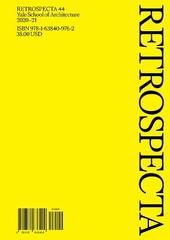
|
Retrospecta 44: Yale School of Architecture 2020-21
Paperback / softback
Main Details
| Title |
Retrospecta 44: Yale School of Architecture 2020-21
|
| Authors and Contributors |
Edited by Claudia Ansorena
|
|
Edited by Bobby Chun
|
|
Edited by Christopher Pin
|
|
Edited by Saba Salkefard
|
| Series | Retrospecta |
|---|
| Physical Properties |
| Format:Paperback / softback | | Pages:154 | | Dimensions(mm): Height 234,Width 184 |
|
| ISBN/Barcode |
9781638409762
|
| Audience | |
|---|
|
Publishing Details |
| Publisher |
Actar Publishers
|
| Imprint |
Actar Publishers
|
| Publication Date |
1 March 2022 |
| Publication Country |
United States
|
Description
Retrospecta catalogs activity at the Yale School of Architecture. Each volume is a snapshot of evolving architectural and graphic design trends. The book demarcates events such as lectures, publication releases, and outstanding circumstances that have uniquely impacted the academic, social, and political environment at the school. Volume 44 covers the activities of the Yale School of Architecture 2020-21 academic year. This year's vicissitudes of curricular hybridity forced upon us a necessary reorientation of the medium we communicate and design with, and a renegotiation of the space we inhabit while we work. Our methods and our material worlds were pushed through the lens of remoteness, and so too were the ideas that followed. As a publication that stands to react and reflect upon the beats of the previous year, two moves were absolutely critical in order to address this fulcrum of architectural education: a virtual extension of Retrospecta, increasing the autonomy and authorship of the student work in a year where projects were developed through incredibly diverse and idiosyncratic means; and a smaller book size that emphasizes a reappraisal of the physical act of reading, a more critical format lending to internal cross-content dialogue, and an heightened importance of the book as an artifact. This volume of Retrospecta sets out to reclaim the solace of solitude by renewing a lost intimacy between story, student, and school, revisiting the reader's relationship to the book as a physical object.
|